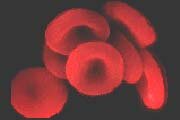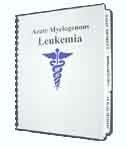 |
||
| HOME | ||
 |
||
| Acute Myelogenous Leukemia (AML) |
||
 |
||
| Other Leukemia Types (ALL / CLL / CML / HCL) |
||
 |
||
| Myelodysplastic Syndrome | ||
 |
||
| Symptoms and Diagnosis | ||
 |
||
| Leukemia Treatment Options | ||
 |
||
| " Chemotherapy | ||
 |
||
| " Blood Stem Cell Transplants | ||
 |
||
| " Radiation and Surgery | ||
 |
||
| " Chemo Side Effects | ||
 |
||
| " Clinical Trials Info | ||
 |
||
| " Coping with Leukemia | ||
 |
||
| " What to Ask Your Doctor | ||
 |
||
| Financial Assistance | ||
 |
||
| At Risk Jobs/Exposure | ||
 |
||
| Leukemia Resources | ||
 |
||
| Survivor's Story | ||
 |
||
| Leukemia News | ||
 |
||
|
Search for information:
|
||

|
Leukemia Cancer News - Return to Menu Minorities needed for bone marrow Program addresses shortage of donors By DAVID GAMBACORTA April 07, 2005 - In fewer than six months, Robin Williams is getting married to her West Oak Lane sweetheart. She's picked out the cake, reserved the church and found the perfect dress. All that stands between Williams and the biggest day of her life is an aggressive, life-threatening disease. The 25-year-old aspiring nurse is battling chronic myeloid leukemia, which forces the body to produce an abnormal number of cancerous white blood cells. To beat the disease and win back her life, Williams needs a bone-marrow transplant. Because she could not find a matching donor within her own family, Williams is hoping to find a match in the National Marrow Donor Program's registry. She faces an uphill battle, though, because she is an African-American. The NMDP has more than 5.5 million potential donors in its registry, but only 430,000 of them are African-American. By contrast, there are more than 1.5 million potential white donors. To save lives, NMDP employees say they must close that gap by changing long-held misconceptions. The organization also has a bone-marrow drive planned for Saturday in West Philadelphia. "Most minorities have never heard of the program, or they don't understand what it's about," said NMDP recruitment specialist Yvette Torres. Many black, Asian and Hispanic communities mistrust the medical establishment, Torres noted, and have little knowledge of the bone-marrow transplant process. "Some people believe that donating is extremely painful, or that it will cause them to somehow get sick," she said. Minorities are also under-represented in the donor registry because few are aware that they can develop leukemia and other cancers. "I never thought that African-Americans got leukemia," Williams confessed from her bed at Fox Chase Cancer Center, where she is receiving chemotherapy. "I was taken completely by surprise." Williams was a student at Community College of Philadelphia in February 2004 when doctors concluded that leukemia was the cause of severe leg pains she had experienced for more than a year. Her white blood-cell count was 20 times higher than a normal person's. "I'm a spiritual person, so I didn't react bad," Williams said, sounding genuinely upbeat. "But I'm also very frustrated. Minorities need to realize that this disease does not discriminate." Though minorities have a one in 20,000 chance of finding a match outside of their families, Williams said three potential matching donors have been discovered in the registry. During a transplant, bone marrow - the spongy tissue inside bones that contains stem cells that produce the body's white and red blood cells - is removed with a needle through the rear hip bone. Doctors take a small percentage of a donor's marrow, which the body replaces in a few weeks. The procedure, done under anesthesia, leaves donors feeling sore, but most go home right away. Recipients, however, have their original bone marrow destroyed by severe doses of chemotherapy and are left without an immune system. They receive the donor's marrow intravenously and wait for a month to see if the new marrow has engrafted itself into their bone cavities. "Being stuck in a room for 30 days is the hardest part," said Curtis Bronson, 30. The Mount Airy resident battled leukemia for eight years before he received a transplant in 2003. He is one of the NMDP's success stories, and he's an African-American. "Education is key," said Bronson, whose donor came from the registry. "If more minorities understood the process, they would come out. How can you not help save a life?" The National Marrow Donor Program will hold a drive on Saturday at the Second Antioch Baptist Church, 912-18 N. 41st St. from 8 a.m. to noon. For information, contact Yvette Torres at 877-261-6786. Experimental Drug For Blood Disorder Christine Webb - (05/26/05) - The FDA is reviewing an experimental drug named Revlimid, aimed at helping a blood disorder. The University of Rochester has conducted clinical trials on the drug that is being used to treat people with a serious form of anemia called MDS that can lead to leukemia. In one study, 75 percent of the patients on the drug either went into complete remission or stabilized enough so they no longer required monthly blood transfusions. Dr. John Bennett, co-author for MDS Research Group said, "it's important for patients because what they see... (loss of hair, etc.) ....and&there is hope that they can get something with fewer side effects." Dr. Bennett hopes this drug will be out for patients to use by the fall. http://www.mds-foundation.org/ Researchers Learn More About Secondary Cancers After Non-Hodgkins Lymphoma The British Journal of Cancer has recently published a study providing evidence that the treatment for non-Hodgkins lymphoma (NHL) may lead to secondary cancers of the bladder, lung, stomach, as well as myeloid leukemias and Hodgkins lymphoma. Lymphomas are malignancies in which cancerous cells arise from the cells of the lymphatic system. The lymphatic system is a drainage system within the body that maintains fluid balance and production of cells called lymphocytes, which fight infection. Lymphomas are divided into two types: non-Hodgkin's lymphoma and Hodgkins lymphoma. Hodgkins lymphoma is characterized by the presence of Reed-Sternberg cells. Non-Hodgkins lymphoma (NHL) includes a large group of various types of cancers of the lymph and immune system. In general, NHL can be further divided into slowly growing cancers and those that progress rapidly. These subtypes of NHL may behave and respond differently to treatment, so the subtype is often the basis for determining the type of treatment to be used. It has long been understood that a cluster of secondary cancers may provide further understanding of the growth and development of a primary cancer. After excluding other factors, the risk of developing a secondary cancer may be attributed to common risk factors shared between the primary and secondary cancersthese may include environmental and genetic factors. The effects of the treatment for the initial cancer, particularly chemotherapy and radiation, may also be factors in secondary cancer development. In some cases, the cause of cancer may be easier to determine, since cancers sharing a common origin are likely to occur more frequently; however cancers that are treatment-related may not have any similar features. In this recent study, 109,451 patients diagnosed with primary NHL were observed to determine the incidence of secondary cancers in comparison to expected rates (estimated rates of cancer occurrence within a given population) of cancer derived from age, sex and calendar periods. Researchers found a 47 percent overall increase in the risk of a second primary cancer after being diagnosed and treated for NHL. A significantly strong increase was observed for cancers of the lip, tongue, oropharynx, nasal cavity, stomach, small intestine, colon, liver, lung, soft tissues, skin melanoma, non-melanoma skin, bladder, kidney, thyroid, Hodgkins lymphoma, lymphoid leukemia and myeloid leukemia. They also looked at primary cancers and found that cancers of the oropharynx, colon, nasal cavity, bladder, kidney, thyroid, soft tissue sarcomas, melanoma, other skin cancers as well as Hodgkins lymphoma and lymphoid leukemia were were associated with an increased risk of developing NHL. Researchers determined that these patterns of risk indicate that the effect of treatment may be linked to the development of lung, bladder and stomach cancers as well as Hodgkins lymphoma and myeloid leukemia. Other more common risk factors, such as pesticides, may be involved in the cancers of the lung, bladder, nasal cavity and soft tissues. The bi-directional effects of multiple cancer sites strongly suggest that immune suppression may also be a common underlying mechanism of cancer development. Researchers concluded that secondary cancers after NHL are often treatment-related, but other sources, such as immune suppression and environmental exposures, may also play a role in the development of secondary cancers and malignancies. Reference: Brennan P, Scelo G, Hemminki K, et al. Second Primary Cancers Among 109,000 Cases of Non-Hodgkins Lymphoma. British Journal of Cancer. 2005; 93: 159-166. |
|
|


